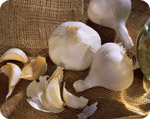Having read the reports of contamination of seafood products imported from China & Vietnam, I no longer buy them. (Though things can become a bit tricky about what's safe to buy when some fresh seafood produce is labeled as
"a mixture of local & imported products" ... with no reference to the source of the imported component in the mix.)
But I was wondering about
garlic, as I use quite a bit of it in my cooking. The home-grown variety costs
way more than the imported Chinese variety. I recently read that garlic is one of China's most profitable exports, which wouldn't surprise me ... our local greengrocer shops & supermarkets appear to seem to be flooded with Chinese garlic.
Recently I read this article which raised my concerns. Any comments on the veracity of the claims of contamination?
Also, are there any controls on Chinese imported garlic on health/contamination grounds in the US and other countries? (According to this article Europe does not accept imported garlic, though whether this is for health or trade reasons I don't know.)
Quote:Conventionally Grown Garlic Contaminated With Chemicals
Monday, March 10, 2008 by: Lynn Berry
 Garlic is recognised as a valuable ingredient in maintaining a healthy life and combating disease. However what looks to be perfectly natural could in fact be treated with chemicals. So the question is where is your garlic from and how has it been treated?
Garlic is recognised as a valuable ingredient in maintaining a healthy life and combating disease. However what looks to be perfectly natural could in fact be treated with chemicals. So the question is where is your garlic from and how has it been treated?
The bulk of the world's garlic is produced in China where the cost of labour significantly reduces the cost of manual processing that garlic requires. For this reason, in those countries that accept imported garlic (including USA, Australia but not Europe), buying imported garlic is cheaper.
Despite this, Chinese garlic does not meet with food safety protocols (at least those in Australia). According to Henry Bell of the Australian Garlic Industry Association, garlic from China is doused in chemicals to stop sprouting, to whiten garlic, and to kill insects and plant matter. He also reports that garlic is grown in untreated sewage (http://www.theage.com.au/news/epicu...) .
Garlic can be whitened by using chlorine or with a mixture of sulphur and wood ash. Whitening garlic helps to make it look healthier and more attractive to consumers. In fact this obsession with white foods has lead to the bleaching of many food products (flour, salt, sugar) using chlorine dioxide or benzoyl peroxide.
Growth inhibitors are used to stop garlic from sprouting and can be made from hormones or chemicals. When garlic begins to sprout, the garlic clove loses much of its potency. Growth inhibitors together with gamma irradiation extend the shelf life of garlic.
Gamma radiation is also used to sterilise many products, and in Australia, this treatment is not accepted for foodstuffs. This does not prevent food treated by gamma radiation to enter the country.
Australia also requires that all garlic regardless of origin is fumigated with methyl bromide at entry to Australia. Methyl bromide is a colourless gas and a potent chemical used as an insecticide, fungicide and herbicide.
It has a variety of uses: in controlling pests, weeds and soil-borne diseases associated with crops and timber products; in protecting stored grains and dried fruit; in industrial feedstock; in refrigerant; as a fire extinguishing agent; for degreasing wool; and for extracting oils from nuts, seeds and flowers (http://www.apvma.gov.au/chemrev/met...) .
Methyl bromide is listed as an ozone depleting substance and, under the Montreal Protocol on Substances that Deplete the Ozone Layer, its use is prohibited. According to the UN it is 60 times more damaging than chlorine and is the base of CFCs (Chlorofluorocarbons). However exemptions have been allowed and that includes the use of methyl bromide for quarantine purposes and feedstock applications.
If inhaled or absorbed through the skin, methyl bromide is toxic to both humans and animals causing chemical burns, kidney damage and damage to the central nervous system. ...<cont>
http://www.naturalnews.com/022801.html